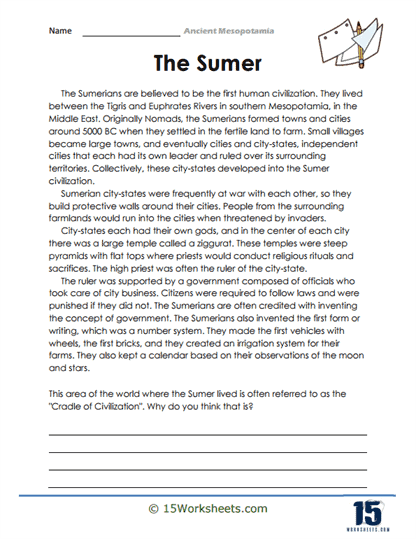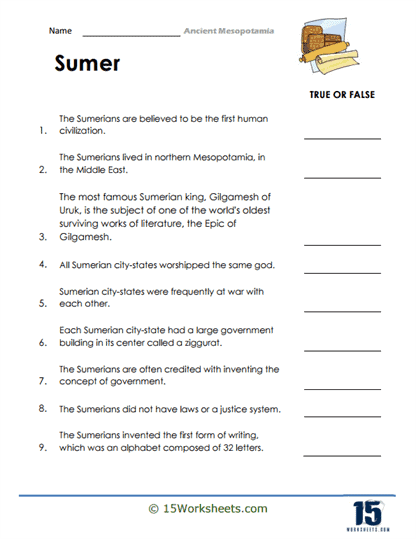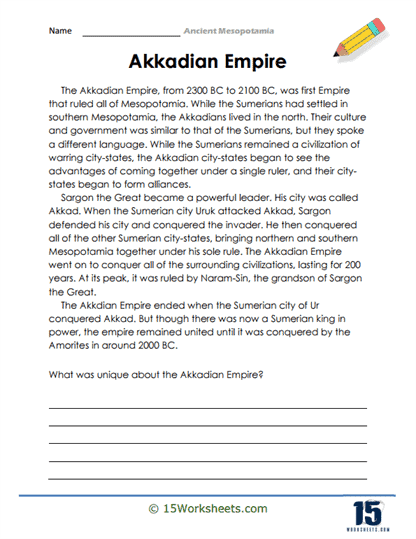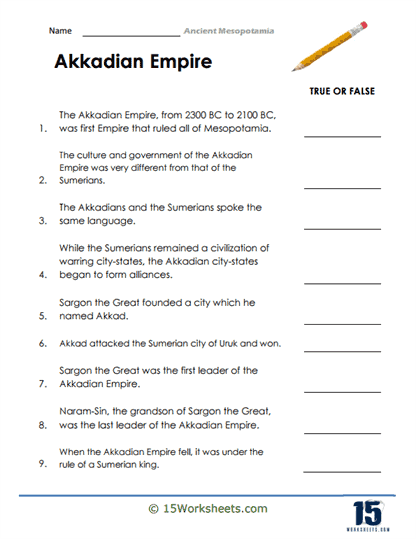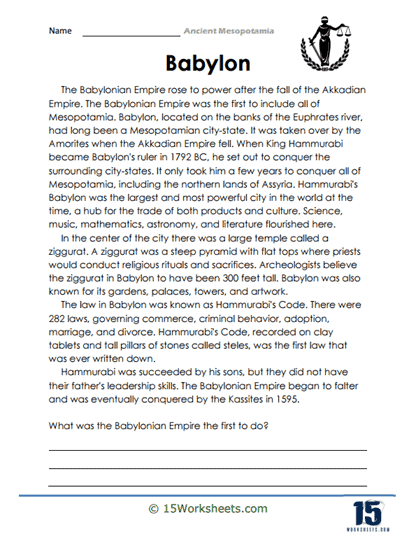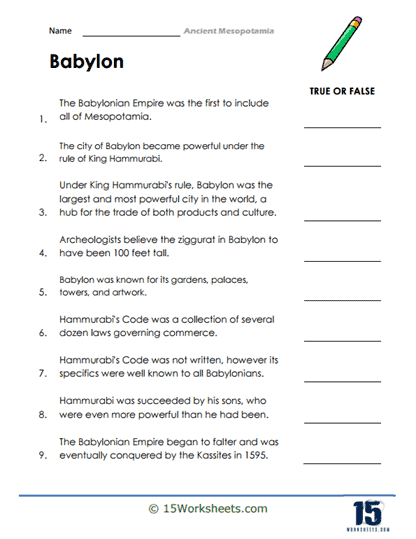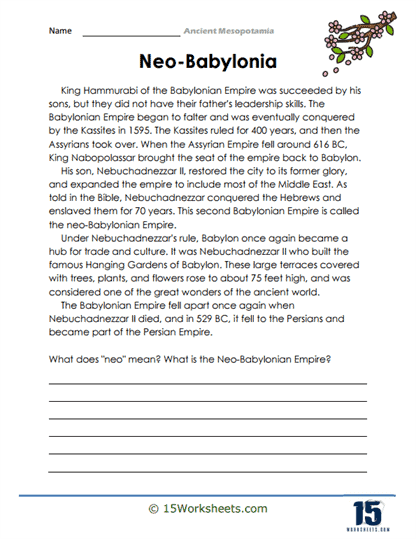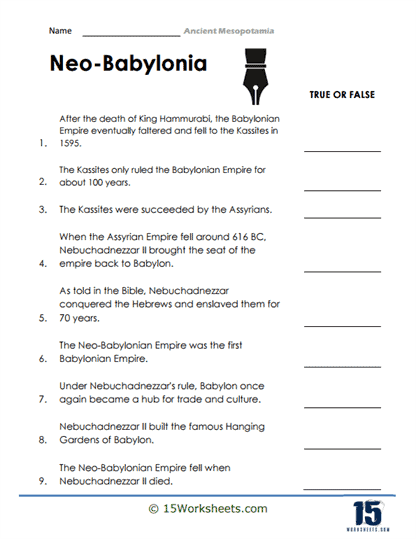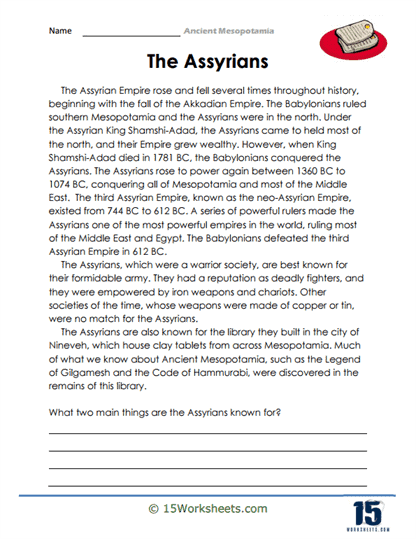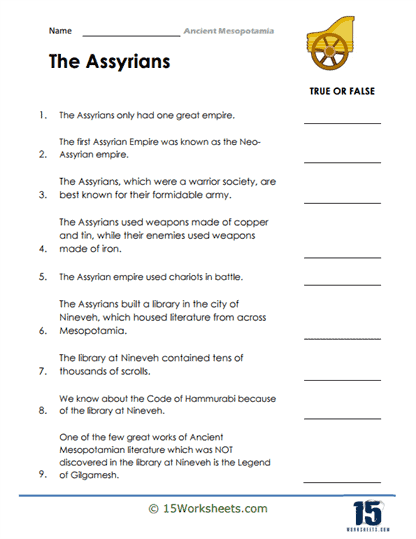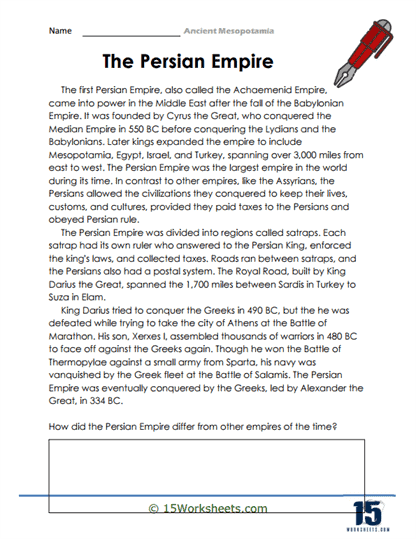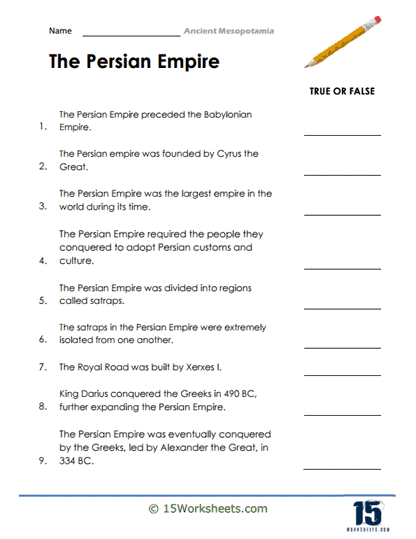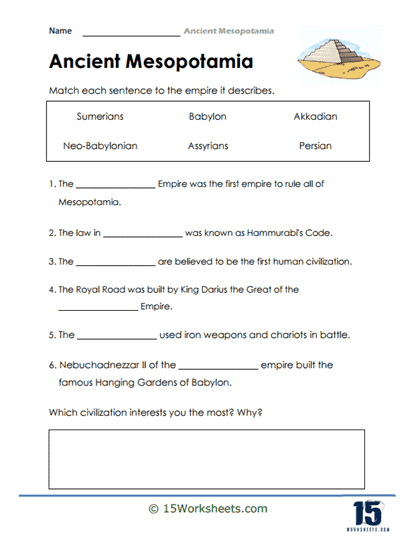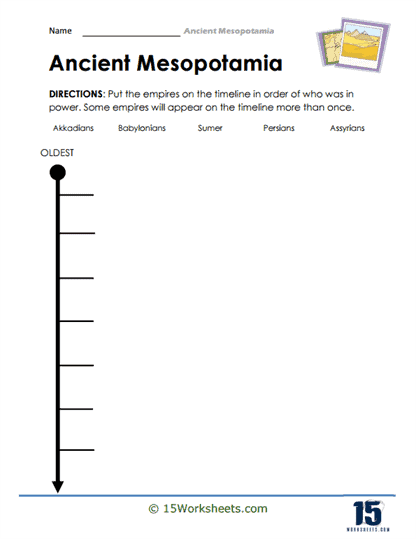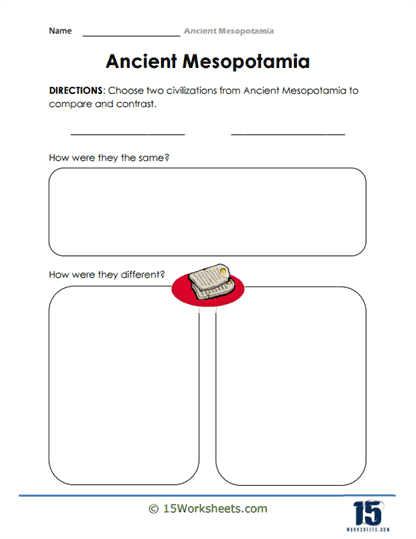Ancient Mesopotamia Worksheets
All About These 15 Worksheets
Students go on a journey through the cradle of civilization with this comprehensive series of 15 worksheets on Ancient Mesopotamia. This collection is designed to transport students back in time, allowing them to explore the rich history, culture, and innovations of this ancient civilization. From reading comprehension exercises to creative activities and research tasks, each worksheet offers a unique opportunity for students to delve into various aspects of Mesopotamian society. Through these worksheets, students will:
- Test their reading comprehension by going through various passages that discuss about the several aspects of life in Ancient Mesopotamia to answer questions as a way to showcase their knowledge and analytical skills;
- Demonstrate their understanding by answering fill-in-the-blanks exercises and true or false questions;
- Be familiar with the order of empires across the timeline according to when they were in power;
- Explore each empire in the Ancient Mesopotamia such as the Akkadian, Babylonian, Sumer, Persian, and Assyrian;
- And exercise their independent research skills by effectively showing the similarities and differences of the Ancient Mesopotamia and another ancient civilization of their choice.
Engaging with this series of worksheets will transport students to the captivating world of Ancient Mesopotamia, fostering a deep understanding and appreciation for its history, culture, and contributions to human civilization. Through the various thought-provoking activities, students develop critical thinking skills, broaden their knowledge of ancient civilizations, and gain insights into the extraordinary achievements of the Mesopotamian people across all of its great empires.
Who Were the Ancient Mesopotamians?
The term “Ancient Mesopotamians” refers to the various peoples and civilizations that inhabited Mesopotamia, an area in the ancient Near East, which corresponds to present-day Iraq, Kuwait, and parts of Syria, Iran, and Turkey. Mesopotamia, also known as the “Cradle of Civilization,” was located between the Tigris and Euphrates rivers, giving it fertile land for agriculture and a strategic position for trade and communication.
Several important civilizations emerged in ancient Mesopotamia, including:
- Sumerian Civilization (c. 4500 BCE – 1900 BCE) – The Sumerians were one of the earliest known civilizations in human history. They established city-states in southern Mesopotamia and made significant advancements in writing (cuneiform), agriculture, city planning, mathematics, and astronomy.
- Akkadian Empire (c. 2334 BCE – 2154 BCE) – The Akkadians, led by Sargon the Great, created the first known empire in history by conquering various Sumerian city-states. They assimilated Sumerian culture and established the Akkadian language as a common tongue throughout the empire.
- Babylonian Empire (c. 1894 BCE – 1595 BCE) – The Babylonians, particularly under Hammurabi, created a powerful empire based in the city of Babylon. Hammurabi’s Code, one of the earliest known legal codes, laid out laws and regulations that governed the society.
- Hittite Empire (c. 1600 BCE – 1180 BCE) – The Hittites established a powerful empire in Anatolia (present-day Turkey) and eventually expanded their influence into Mesopotamia. They were known for their advanced military technology and diplomatic skills.
- Assyrian Empire (c. 1365 BCE – 609 BCE) – The Assyrians, centered in the city of Ashur, rose to prominence as a formidable military power. They built a vast empire through aggressive conquests and developed highly organized administrative systems.
- Neo-Babylonian Empire (c. 626 BCE – 539 BCE) – The Neo-Babylonians, led by King Nebuchadnezzar II, revived the glory of Babylon and established a powerful empire. They are known for their architectural achievements, including the Hanging Gardens of Babylon.
- Achaemenid Empire (Persian Empire) (c. 550 BCE – 330 BCE) – The Achaemenids, led by Cyrus the Great, conquered Mesopotamia and established the Persian Empire, which became one of the largest and most influential empires in the ancient world. They implemented administrative reforms and embraced cultural diversity within their vast territories.
These civilizations and empires significantly shaped the history, culture, and development of Mesopotamia, leaving behind enduring legacies in areas such as governance, law, architecture, and literature. Their achievements and contributions continue to fascinate scholars and provide insights into the complexities of ancient civilization.
Ancient Mesopotamia Today
Today, the region that was once ancient Mesopotamia is primarily occupied by the modern nation of Iraq, with parts in Kuwait, Syria, Iran, and Turkey. The population of this region is diverse, comprising various ethnic, religious, and linguistic groups. Some of the prominent groups living in the region include:
- Arabs – The majority of the population in Iraq and the surrounding region are Arabs, who speak Arabic and follow various religious traditions, primarily Islam.
- Kurds – The Kurds are an ethnic group who inhabit parts of Iraq, Iran, Turkey, and Syria. They have their own distinct culture and language, Kurdish, and are predominantly Sunni Muslims.
- Assyrians – Assyrians are an ethnic group with a long history in the region, tracing their roots back to ancient Assyria. They speak Aramaic and are predominantly Christians, following the Assyrian Church of the East, the Syriac Orthodox Church, and the Chaldean Catholic Church.
- Turkmen – Turkmen are an ethnic group who mainly live in northern Iraq and are closely related to the Turks of Turkey. They speak Turkmen and are predominantly Sunni Muslims.
- Other groups – There are also smaller populations of various other ethnic and religious groups in the region, such as Yazidis, Shabaks, and Armenians.
The ancient Mesopotamian heritage is a source of pride for many people in the region, as it represents a rich and influential history that has shaped the development of human civilization. This heritage is visible in the form of ancient ruins, such as the ziggurats of Ur and Babylon, the remains of the Assyrian cities of Nineveh and Nimrud, and the countless artifacts displayed in museums and archaeological sites.
However, modern inhabitants of the region face numerous challenges, including political instability, armed conflicts, terrorism, and economic struggles. Preservation and appreciation of the ancient Mesopotamian heritage are often overshadowed by these challenges, but many individuals and organizations continue to work towards raising awareness, protecting, and promoting the cultural legacy of ancient Mesopotamia.

